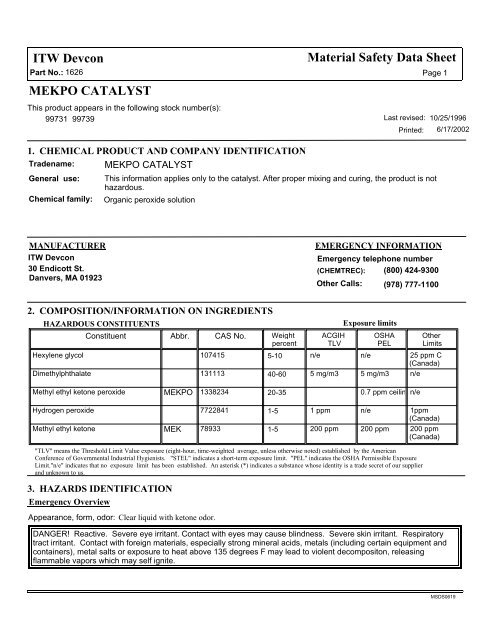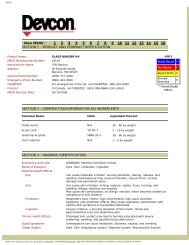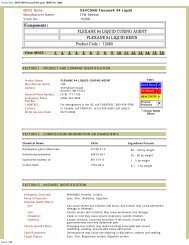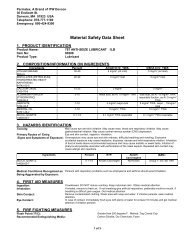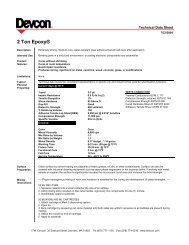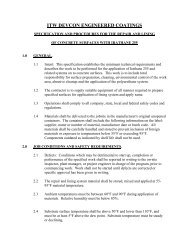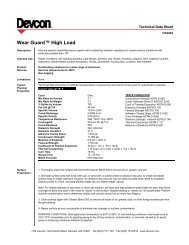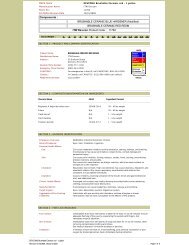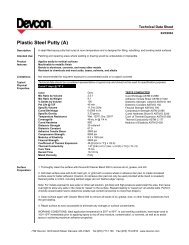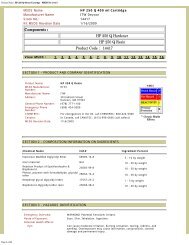MEKPO CATALYST ITW Devcon Material Safety Data Sheet
MEKPO CATALYST ITW Devcon Material Safety Data Sheet
MEKPO CATALYST ITW Devcon Material Safety Data Sheet
Create successful ePaper yourself
Turn your PDF publications into a flip-book with our unique Google optimized e-Paper software.
<strong>ITW</strong> <strong>Devcon</strong>Part No.: 1626<strong>MEKPO</strong> <strong>CATALYST</strong>This product appears in the following stock number(s):99731 99739<strong>Material</strong> <strong>Safety</strong> <strong>Data</strong> <strong>Sheet</strong>Page 1Last revised: 10/25/1996Printed: 6/17/20021. CHEMICAL PRODUCT AND COMPANY IDENTIFICATIONTradename: <strong>MEKPO</strong> <strong>CATALYST</strong>General use:Chemical family:This information applies only to the catalyst. After proper mixing and curing, the product is nothazardous.Organic peroxide solutionMANUFACTURER<strong>ITW</strong> <strong>Devcon</strong>30 Endicott St.Danvers, MA 01923EMERGENCY INFORMATIONEmergency telephone number(CHEMTREC): (800) 424-9300Other Calls: (978) 777-11002. COMPOSITION/INFORMATION ON INGREDIENTSHAZARDOUS CONSTITUENTSConstituent"TLV" means the Threshold Limit Value exposure (eight-hour, time-weighted average, unless otherwise noted) established by the AmericanConference of Governmental Industrial Hygienists. "STEL" indicates a short-term exposure limit. "PEL" indicates the OSHA Permissible ExposureLimit."n/e" indicates that no exposure limit has been established. An asterisk (*) indicates a substance whose identity is a trade secret of our supplierand unknown to us.3. HAZARDS IDENTIFICATIONEmergency OverviewAbbr.Appearance, form, odor: Clear liquid with ketone odor.CAS No.WeightpercentACGIHTLVExposure limitsHexylene glycol 107415 5-10 n/en/eDANGER! Reactive. Severe eye irritant. Contact with eyes may cause blindness. Severe skin irritant. Respiratorytract irritant. Contact with foreign materials, especially strong mineral acids, metals (including certain equipment andcontainers), metal salts or exposure to heat above 135 degrees F may lead to violent decompositon, releasingflammable vapors which may self ignite.OSHAPELDimethylphthalate 131113 40-60 5 mg/m3 5 mg/m3 n/eMethyl ethyl ketone peroxide <strong>MEKPO</strong> 1338234 20-35 0.7 ppm ceilingn/eOtherLimits25 ppm C(Canada)Hydrogen peroxide 7722841 1-5 1 ppm n/e 1ppm(Canada)Methyl ethyl ketone MEK 78933 1-5 200 ppm 200 ppm200 ppm(Canada)MSDS0619
<strong>ITW</strong> <strong>Devcon</strong>Part No.: 1626Potential health effectsPrimary routes of exposure:Symptoms of acute overexposure:Skin: May cause severe irritation.Eyes: May cause severe irritation. May cause blindness.Inhalation:Mucous membrane irritant.Ingestion:May irritate gastrointestinal tract, and cause nausea and vomiting.Effects of chronic overexposure:Negative ames testCarcinogenicity -- OSHA regulated: No ACGIH: No National Toxicology Program: NoMedical conditions which may be aggravated by exposure:None reported4. FIRST AID MEASURESFirst aid for eyes:Flush eye with clean water for at least 15 minutes while gently holding eyelids open. Get immediate medicalattention.First aid for skin:Wash thoroughly with soap and warm water. Consult a physician if irritation develops.First aid for inhalation:Remove patient to fresh air. Administer oxygen if breathing is difficult. Get medical attention.First aid for ingestion:Do not induce vomiting. If patient is conscious, dilute by giving water. Get prompt medical attention.5. FIRE FIGHTING MEASURESExtinguishing media:WaterFlash Point (°F): 151International Agency for Research on Cancer: NoCancer-suspect constituent(s) : NoneCarbon dioxide Dry chemical Foam Alcohol foamMethod: TCCExplosive limits in air (percent) -- Lower: n/dSkin contact Skin absorption Eye contact Inhalation IngestionUpper: n/dSpecial firefighting procedures:If large amounts of material are involved, evacuate area and fight fire from safe distance. Cool fire-exposedcontainers with water spray. Fire fighters should wear self-contained breathing apparatus.Unusual fire and explosion hazards:Methyl ethyl ketone peroxide can decompose violently if heated strongly while confined.Hazardous products of combustion:Oxides of Carbon; Decomposition products are flammable and may autoignite.<strong>Material</strong> <strong>Safety</strong> <strong>Data</strong> <strong>Sheet</strong>Page 2MSDS0619
<strong>ITW</strong> <strong>Devcon</strong>Part No.: 16266. ACCIDENTAL RELEASE MEASURESSpill control:Evacuate area; eliminate ignition sources; wear protective clothing and overshoes.Containment:Dike, contain and absorb with clay, sand or other suitable material.Cleanup:Absorb spill on inert material such as vermiculite and transfer with nonsparking tools to impervious container.Special procedures:Prevent spill from entering drainage/sewer systems, waterways, and surface waters. Notify appropriate authorities asrequired.7. HANDLING AND STORAGEHandling precautions:Avoid contact with skin, eyes, or clothing. Wash thoroughly with soap and water after using and particularly beforeeating, drinking, smoking, applying cosmetics, or using toilet facilities.Launder contaminated clothing and protective gear before reuse. Discard contaminated leather articles.Provide appropriate ventilation/respiratory protection against decomposition products (see Section 10) duringwelding/flame cutting operations and against particulates during sanding/grinding (3 mg/m3). Use nonsparkingequipment.Storage:Store in a cool, dry area away from high temperatures and flames. Storage above 100 F will reduce useful life of thematerial. Keep from heat, sparks, and open flame. Exposure to high heat can cause violent reaction. Do not storenear combustibles. Contact with foreign materials, especially strong mineral acids, metals (including certainequipment and containers) or metal salts or exposure to heat above 135 degrees F may lead to violentdecompositon, releasing flammable vapors which may self ignite.8. EXPOSURE CONTROLS/PERSONAL PROTECTIONEngineering controlsVentilation :Local exhaust is recommended for confined areas. General mechanical ventilation is adequate for normal use.Other engineering controls :Have emergency shower and eye wash available.Personal protective equipmentEye and face protection:<strong>Safety</strong> glasses with side shields, or splash goggles.Skin protection:Chemical resistant rubber gloves are recommended.Respiratory protection:None required at normal handling temperatures.<strong>Material</strong> <strong>Safety</strong> <strong>Data</strong> <strong>Sheet</strong>Page 3MSDS0619
<strong>ITW</strong> <strong>Devcon</strong>Part No.: 1626<strong>Material</strong> <strong>Safety</strong> <strong>Data</strong> <strong>Sheet</strong>Page 49. PHYSICAL AND CHEMICAL PROPERTIESSpecific gravity: 1.08Melting point (°F): < 0Boiling point (°F):Vapor density (air = 1):n/dn/eVapor pressure (mmHg): n/e at 0 °FVOC (grams/liter): 0.27Percent volatile by volume: Approx. 3Percent solids by weight: Approx. 96Evaporation rate (butyl acetate = 1): n/eSolubility in water:NilpH (5% solution or slurry in water): Neutral10. STABILITY AND REACTIVITYThis material is chemically unstable.Hazardous polymerization will not occur.Conditions to avoid :Heat, spark, open flame, contamination, and frictionIncompatible materials:Strong acids and bases, strong oxidizers, amines, acetone, transition metal salts, promoters and reducing agents.Hazardous products of decomposition:Flammable and toxic fumes including organic acids; carbon monoxide and carbon dioxide from complete combustionConditions under which hazardous polymerization may occur:None11. TOXICOLOGICAL INFORMATIONAcute oral effects:LD50 (rat): No data availableAcute dermal effects:LD50 (rabbit): No data availableAcute inhalation effects: LC50 (rat): No data available Exposure: 4 hours.Subchronic effects:No data available.Carcinogenicity, teratogenicity, and mutagenicity:Ames Test: Negative.Other chronic effects:No data available.Toxicological information on hazardous chemical constituents of this product:MSDS0619
<strong>ITW</strong> <strong>Devcon</strong>Part No.: 1626<strong>Material</strong> <strong>Safety</strong> <strong>Data</strong> <strong>Sheet</strong>Page 5ConstituentOral LD50(rat)Dermal LD50(rabbit)Inhalation LC504hr, (rat)Hexylene glycol 3700 mg/kg 8560 mg/kg n/dDimethylphthalate 6800 mg/kg >20 ml/kg n/dMethyl ethyl ketone peroxide 484 mg/kg n/d n/dHydrogen peroxide n/d n/d n/dMethyl ethyl ketone 2737 mg/kg 6480 mg/kg 33234 mg/m^312 ECOLOGICAL INFORMATIONEcotoxicity:No data availableMobility and persistence:No data available.Environmental fate:No data available.'n/d' = 'not determined'13. DISPOSAL CONSIDERATIONSPlease see also Section 15, Regulatory Information.Waste management recommendations:Dispose of in accordance to applicable federal, state, and local regulation.14. TRANSPORT INFORMATIONProper shipping name: Organic peroxide type D, liquidTechnical name : Methyl Ethyl Ketone Peroxide, < 45%Hazard class : 5.2UN number: 3105Packing group:IIEmergency Response Guide no.: 145IMDG page number: N/AOther:ORM-D :LtdQty : NMSDS0619
<strong>ITW</strong> <strong>Devcon</strong>Part No.: 162615. REGULATORY INFORMATIONU.S. Federal RegulationsTSCAAll : ingredients of this product are listed, or are exempt from listing, on the TSCA inventory.The following RCRA code(s) applies to this material if it becomes waste:U160; D035Regulatory status of hazardous chemical constituents of this product:ConstituentExtremelyHazardous*ToxicChemical**<strong>Material</strong> <strong>Safety</strong> <strong>Data</strong> <strong>Sheet</strong>CERCLARQ (lbs)TSCA 12B ExportNotificationHexylene glycol No No 0.0 Not requiredDimethylphthalate No Yes 5000.0 RequiredMethyl ethyl ketone peroxide No No 0.0 Not requiredHydrogen peroxide Yes No 0.0 Not requiredMethyl ethyl ketone No Yes 5000.0 Not requiredPage 6*Consult the appropriate regulations for emergency planning and release reporting requirements for substances on the SARA Section 301Extremely Hazardous Substance list.**Substances for which the "Toxic Chemical" column is marked "Yes" are on the SARA Section 313 list ofToxic Chemicals, for which release reporting may be required. For specific requirements, consult the appropriate regulations.For purposes of SARA Section 312 hazardous materials inventory reporting, the following hazardclasses apply to this material: - Immediate health hazard -- Reactivity hazard -Canadian regulationsWHMIS hazard class(es) : D2B; CAll components of this product are on the Domestic Substances List.16. OTHER INFORMATIONHazardous <strong>Material</strong>sIdentification System (HMIS)ratings:Health3*Flammability2Reactivity2The information and recommendations in this document are based on the best information available to us at the time of preparation, but we make noother warranty, express or implied, as to its correctness or completeness, or as to the results of reliance on this document.MSDS0619


